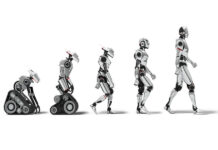Everyone ages and dies unconditionally from the moment they are born. However, unlike in the past, with the development of science and technology, human life expectancy is increasing, and the demographic structure is aging. Nowadays, when I get on the subway, I see more elderly people than children. As a result, the importance of medical technology and science and technology for old-age diseases has recently emerged. However, experts have also raised concerns.
The New York Times (NYT) analyzed the declining birthrate and aging population in Italy, a developed country in the West, and published a feature article titled “A ‘Silver Tsunami’ Is Hitting the World.” The term “silver tsunami” refers to the rapid aging of the population. It refers to a phenomenon in which the birth rate plummets, and the number of elderly people increases simultaneously around the time when baby boomers born in the 50s, 60s, and 70s retire, causing various social problems.
What does aging, the inevitable and universal experience of all human beings, and the increasing average age of people on Earth mean? Is it unconditionally bad? What should we do about the inevitable aging? In my essay, I’m going to explain the diseases that come with aging, the problems they present, and the science and technology as the solution to solve those problem.
The global population has doubled in 48 years, reaching 8 billion in 2022 from 4 billion in 1974. Concurrently, the planet’s population is aging, with the number of U.S. citizens aged 65 and older predicted to rise from 52 million in 2018 to 95 million by 2060. This demographic shift will mean 23% of the population will be 65 and older, up from 16%. Over 10,000 baby boomers in the U.S. are turning 65 daily, contributing to this increase.
The growth in the elderly population presents challenges, including strain on healthcare systems, as there will be a more than 50% rise in those needing nursing home care by 2030 and a doubling in elderly care demand by 2050. This surge is also linked to an expected rise in Alzheimer’s disease cases. Financial pressures will mount on Social Security and Medicare, with spending projected to grow from 8.7% of the GDP today to 11.8% in 2050. The focus on elderly services could limit resources for youth services, and the GDP growth might slow due to a diminishing youth population and growing retirement-age demographic.
The International Gerontological Society defines an elderly person as one whose tissues are impaired and can’t adapt to environmental changes, leading to functional decline. With a decrease in death rates from infectious diseases, chronic illnesses like cancer, heart disease, high blood pressure, and others have become more prevalent.
Malignant neoplasms are the primary cause of death in those 65 and older, followed by heart diseases and COVID-19. Chronic diseases, influenced by the environment, have a slow onset and don’t immediately resolve upon manifestation. Neurodegenerative diseases, such as Alzheimer’s and Parkinson’s, are prime examples of chronic conditions. Despite their prevalence, our understanding of the genetic factors influencing these diseases is limited, complicating the discovery of their causes, treatments, and cures.
Around 50 million people globally have dementia, with numbers rising. Alzheimer’s disease accounts for 50%-80% of cases, while vascular dementia accounts for 10%-25%. Other causes include degenerative brain diseases, trauma, tumors, and metabolic disorders, among others. Dementia is irreversible, intensifying the demand for elderly care.
In the U.S., over 6 million people have Alzheimer’s, projected to increase to 7.1 million by 2050 and 13.8 million by 2025. Deaths from Alzheimer’s have surged by 68% even as other disease mortality rates drop. The disease’s primary believed cause is excess beta-amyloid proteins damaging nerve cells.
While no cure exists, there are drugs that can mitigate symptoms and delay progression, like Acetylcholinesterase inhibitors. These drugs boost neurotransmitter acetylcholine levels, slowing disease progression for a limited period, but they don’t cure Alzheimer’s.
The U.S. and Japan are facing an increasing demand for nurses due to the aging baby boomer generation. Despite the rising need, fewer individuals are pursuing nursing careers, predicting significant future shortages. The U.S. is projected to require 3.2 million nurses by 2024, a 16% increase from 2014, while Japan anticipates a shortfall of 30,000 to 130,000 nurses by 2025.
A consequence of younger people moving into elderly care roles is the potential impact on the workforce for other industries. To address these challenges, Japan is advancing the development of nursing robots. In hospitals, robots like “Tug” in San Francisco Hospital aid nurses by transporting items and navigating the facility using sensors and Wi-Fi. Beyond logistical support, robots are being designed to provide emotional interaction for the elderly to combat feelings of isolation and loneliness.
Robots like “Moxie” can display social cues through LED eyes, while “Paro”, a seal-shaped robot from Japan, assists in psychotherapy by recognizing its surroundings and understanding simple words. The shift towards more human-like and pet-like robots aims to facilitate natural interactions with the elderly, forecasting a future where robots play crucial roles in elderly care and companionship.
So are these medical advances only good for us? Modern society is plagued by overmedicalization and substance abuse. The United States has the highest healthcare spending as a percentage of gross domestic product (GDP). Healthcare overuse accounted for $750 billion, or about one-third, of the $2.6 trillion in healthcare spending in 2012.
Overuse of treatments can put patients at risk of complications unnecessarily. The United Nations(UN) estimates that drug overdoses cause 300,000 deaths per year worldwide. From 1968 to 2019, 1,015,060 U.S. residents died from drug overdoses.
Leonard J. Paulozzi, a medical epidemiologist at the U.S. Centers for Disease Control and Prevention, testified that the rise in unintentional overdose deaths suggests a link to the increased use of prescription drugs, particularly opioid painkillers. In 2013, 43,982 people died of drug overdoses in the United States. It caused more deaths than motor vehicle crashes. Of those, 22,767 (51.8%) were related to prescription drugs.
I think about how many pills I’ve taken today, and I’m pretty sure I’ve taken at least one. I realize that we are a drug-addicted society. For example, antibiotics used to only hit easy targets (like the cell wall or metabolic processes of bacteria), reducing the number of targets.
However, more and more bacteria are becoming resistant to antibiotics. This has led to a paradigm shift for pharmaceutical companies to develop blockbuster drugs. From ‘life-saving drugs’ to ‘drugs that make life more comfortable’, which are in constant demand in an aging society.
From the earliest records of civilization, we know that disease, death, and how long we can live are among the oldest concerns of humankind. Now it is time to think about the right application of future medical technologies while considering the issues of life and death. Also, these changes must be understood in the context of the passage of time. We cannot escape the sequence of aging and death because once time passes, it does not come back. Therefore, we can slow down aging, but it is impossible to completely stop or reverse aging.
As the aging process accelerates, medical technology and life sciences are being developed for successful disease management. The time is coming when anyone can easily treat diseases anywhere, regardless of location. However, despite the changes and advances in technology, healthy aging still depends on our lifestyle and environment.
Recently, the Institute of Healthy Aging at University College London (UCL) extended the lifespan of fruit flies by 48% with a combination of drugs. They found that early life experiences can influence gene activity later in life and even affect lifespan. In the published study, scientists found that gene expression “memory” can persist throughout life, and that health in old age depends in part on what a person experienced when they were young or even in the womb.
Building on previous research, the scientists found that fruit flies fed a high-sugar diet as children had shorter lifespans as adults, even after their diets improved. This suggests a new target for improving health in old age. This is why it’s important to change your lifestyle, especially your diet, before you get too old.
Taken together, these studies show that eating a healthy diet, exercising regularly, drinking alcohol in moderation, and not smoking can add more than 20 years to your life. Add to this the reduction of air pollution, the amount of chemicals we are exposed to in our environment, and the amount of stress we experience. In the end, we can slow down aging by improving our living environment.
By: Oh Songyeon
Write and Win: Participate in Creative writing Contest & International Essay Contest and win fabulous prizes.















